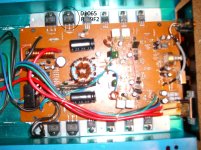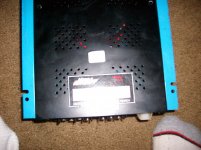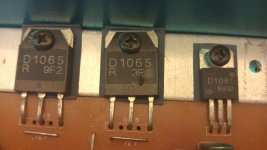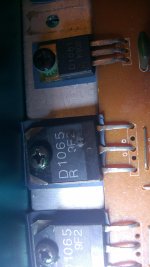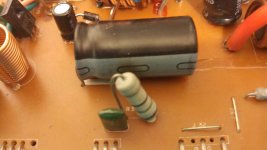Ok guys, I need some help finding out what output transistors I need to fix this amplifier. I can't find a schematic ANYWHERE on the web for these 1990-1993 amplifiers. I have found a bad transistor (shown in pic) So what the heck should I do? replace that specific transistor (which I can't find anywhere) or replace the whole set?
Attachments
Last edited:
The 1065s aren't output transistors. They're being used in the power supply.
Did you remove it from the board to check it? If not, all four of the 1065s should read as shorted in the board.
These older components are the types commonly counterfeited so you should be aware that any you buy may be counterfeit and not up to spec.
Did you check the rest of the transistors?
Did you remove it from the board to check it? If not, all four of the 1065s should read as shorted in the board.
These older components are the types commonly counterfeited so you should be aware that any you buy may be counterfeit and not up to spec.
Did you check the rest of the transistors?
No, I did a visual inspection & the one circled in the picture has a burn mark, I read in another thread that they should be replaced in sets so that's what I plan to do. I don't know much about amp circuitry so I'm somewhat lost. I did a test in my vehicle & it powers on for like 2-3 seconds & you hear faint music & then the fuse blows & you hear a high pitched noise. Hope this helps.
Well I tested them while connected to the PCB, should I de-solder them & what exactly should I be testing for?
Did you read the entire basic repair page (including the parts that you didn't think were relevant)?
You test to see if any are shorted as an initial test.
You test to see if any are shorted as an initial test.
I searched for "basic repair" but couldn't find anything relevant, can you give me the link?.
[EDIT] I found the links on your profile :-D thanks.
[EDIT] I found the links on your profile :-D thanks.
Last edited:
ok I checked the transistors D1065, D1061 & the other small ones & they keep giving strange results. Sometimes they read shorted & then when I test the next one & come back they read fine. I'm not sure what to make of these. :-(
If they're shorted, they will always read shorted. What's likely happening is that there is a parallel cap (those across the B+ and ground) that are charging and discharging making the meter read as though there is a short.
So far, you haven't provided any information to indicate that any components are actually defective.
What size fuse did it blow?
What size fuse did it blow?
Blew the 20A fuse,but heard a faint amount of music before it blew, tried several fuses at various gain levels to see if anything would change. Also one of the transistors has a burn mark, the one in the picture. I'm confused by all the math in calculating things though, soo many numbers & I get confused. What would you recommend I do?
They are 2sd1065, they appear to be in the power supply section. If one of them blew up (as shown in the picture) it is a good idea to replace all of them (2sd1065) also check to see if there's any resistors on any of the three pins for that transistor, they may be damage and will also need replacement. Once you remove the board check the bottom of the board for any components (SMD) that may be damaged as well (if it has any, not sure as I don't have that amplifier or schematics).
Once you replace all four transistors, power it up with a 5-10amp fuse to protect the amp from any further damage.
BTW, Perry is very busy with other projects so he wont be able to help for the time being. He has helped many here and we will try to help as much as possible.
Once you replace all four transistors, power it up with a 5-10amp fuse to protect the amp from any further damage.
BTW, Perry is very busy with other projects so he wont be able to help for the time being. He has helped many here and we will try to help as much as possible.
There might be better subs out there but if you can't compare data sheets then I suggest sticking with originals. Unless someone that has sub that specific transistor has experience then they might suggest it to you...unfortunately I haven't so I can't comment on that.
You can also use certain web sites that allow you to insert certain data and they will provide a list of possible subs. Google that specific transistor and you might get some good leads on finding a sub with better specs. Other than that then stick with original.
You can also use certain web sites that allow you to insert certain data and they will provide a list of possible subs. Google that specific transistor and you might get some good leads on finding a sub with better specs. Other than that then stick with original.
Also, how do I check the resistors next to the trans? they aren't giving accurate readings, unless my multimeter is malfunctioning, why do they all say 0.01 ohm?
EDIT: 145ohms, must have not plugged the leads in properly.
Is it normal for resistors placed next to components to give off enough heat to leave brown marks on the nearby capacitor?
EDIT: 145ohms, must have not plugged the leads in properly.
Is it normal for resistors placed next to components to give off enough heat to leave brown marks on the nearby capacitor?
Attachments
Last edited:
According to the picture it should read 180ohm with a tolerance of 9ohm, so anything between 171 and 189 is acceptable.
145ohm is off of tolerance and should be replace with a 180ohm 5% 1watt (or 2watt) resistor. Looks like a ceramic resistor.
145ohm is off of tolerance and should be replace with a 180ohm 5% 1watt (or 2watt) resistor. Looks like a ceramic resistor.
- Status
- Not open for further replies.
- Home
- General Interest
- Car Audio
- O/S Mobile Authority 116ZX amplifier
